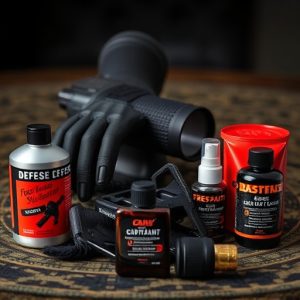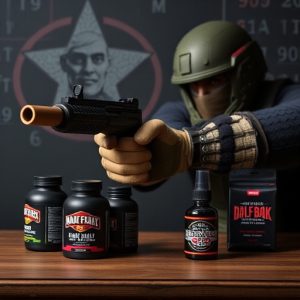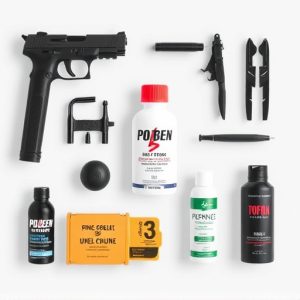Pepper Spray as Personal Defense: Science and Selection Guide
Pepper spray is an indispensable tool for personal defense due to its ability to temporarily incapa…….
Pepper spray is an indispensable tool for personal defense due to its ability to temporarily incapacitate an attacker. It contains oleoresin capsaicin (OC), which causes intense irritation upon contact with the eyes, face, or respiratory system, leading to disorientation and providing a critical escape opportunity. Available in various forms, including canisters, gel, and foam, each type serves different defensive needs. Pepper spray is a non-lethal, ethical, and legal choice for self-defense, complementing other safety strategies like awareness and the use of alarms. Capacitance pepper sprays are particularly popular; they exploit the active ingredient TRVP1 receptors to induce pain, coughing, and tearing, rendering an assailant immobile for up to 45 minutes. The effects can be easily reversed with water, highlighting its safety. Selecting the right pepper spray involves considering its potency, delivery mechanism, and ease of deployment, with stronger formulations offering greater stopping power. Carry options range from keychain models for urban settings to larger cans for open spaces. Training is essential to ensure effective use within legal boundaries, ensuring that personal defense products like pepper spray are part of a well-considered self-protection plan tailored to individual needs and environments.
When considering personal defense products, pepper spray emerges as a widely recognized and effective option. This article delves into the intricacies of pepper spray, shedding light on its role in self-defense scenarios. We explore the scientific principles that render it an incapacitating agent, its varying formulations, and how to select the most suitable pepper spray for your safety needs. Understanding the potency and application of this defensive tool is paramount for those looking to enhance their personal security measures. Join us as we navigate through the essential aspects of pepper spray within the realm of personal defense products.
Understanding Pepper Spray as a Personal Defense Product
Pepper spray is a widely recognized personal defense product, formulated to temporarily incapacitate an assailant. Its efficacy stems from its active ingredient, oleoresin capsicum (OC), which induces an intense irritation upon contact with the eyes, face, and respiratory system of an attacker. When deployed, it triggers a cascade of neurological signals that signal pain, effectively disorienting the aggressor and providing the user with a critical escape opportunity. Understanding the mechanical and chemical properties of pepper spray is crucial for its effective use as a deterrent in personal defense situations.
Available in various formulations and delivery systems, such as canisters, gel, and foam, pepper spray is one of the most popular personal defense products on the market. Users have a range of options to choose from, each designed to address specific needs or concerns. The key to its utility lies in its non-lethal nature; it incapacitates the threat without causing long-term harm. This makes it an attractive option for individuals seeking a reliable means of self-defense that adheres to ethical and legal standards. When integrated into a comprehensive personal defense strategy, which includes awareness, avoidance, and alarm measures, pepper spray serves as a vital component in ensuring one’s safety against potential threats.
The Science and Mechanism Behind Pepper Spray's Effectiveness
Capacitance pepper sprays are a widely recognized personal defense product, designed to incapacitate an assailant by disorienting them through the effects of its primary active component, oleoresin capsaicin. This compound is derived from chili peppers and induces an intense irritation upon contact with mucous membranes or skin. The mechanism behind its effectiveness lies in its ability to disrupt the normal function of nerves that detect heat and pain. When deployed, the spray’s fine droplets penetrate the eyes, respiratory tract, or exposed skin of an aggressor, activating TRVP1 receptors associated with sensing noxious thermal and mechanical stimuli. This activation triggers a cascade of physiological responses, including intense pain, uncontrollable coughing, and profuse eye tearing, effectively immobilizing the individual for a period ranging from 30 to 45 minutes.
The efficacy of pepper spray as a personal defense product is further enhanced by its legal status and availability in many regions, making it an accessible choice for individuals seeking to protect themselves. Its active ingredients are non-lethal and, when used correctly, cause temporary disorientation rather than permanent harm. The effects are reversible once the contaminated area is thoroughly flushed with water, which is why it’s considered a non-lethal self-defense tool. It’s important for users to understand the proper techniques for aiming and deploying the spray to ensure safety and maximize effectiveness. Training courses and instructional materials are available to educate individuals on how to effectively use pepper sprays as part of their personal defense strategy.
Choosing the Right Pepper Spray for Your Personal Defense Needs
When considering personal defense products, pepper spray stands out as a non-lethal deterrent that can effectively protect against potential threats. Selecting the right pepper spray is crucial for your personal defense needs, as it’s not merely about having the product but understanding its application and limitations. Factors such as sprays’ chemical potency, delivery system, and deployment ease are significant when choosing a pepper spray. High-strength formulations offer greater stopping power against attackers, while discreet carry options ensure you have immediate access in critical moments.
Moreover, the type of pepper spray that suits your personal defense strategy depends on your environment, comfort level with the product, and legal restrictions in your area. Keychain models provide a quick response for urban settings, whereas larger cans with a more extended range are ideal for open spaces or rural areas. Additionally, consider the availability of training resources to familiarize yourself with effective deployment techniques. Investing in personal defense products like pepper spray is about finding the balance between safety and practicality; this means selecting a product that aligns with your specific self-defense plan and circumstances.


